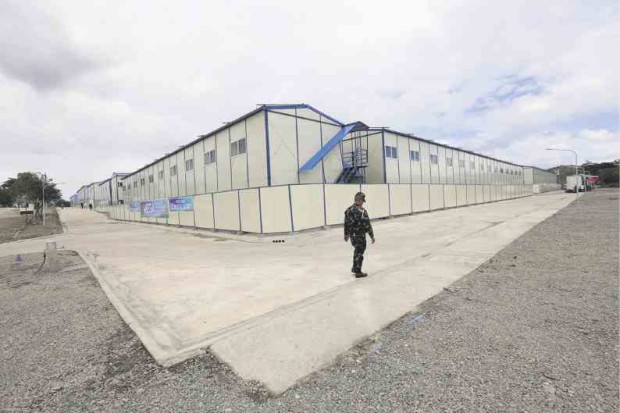Mega drug rehab center a mistake? Execs disagree

The Department of Health says some buildings in the Mega Drug Abuse Treatment and Rehabilitation Center, built inside Fort Magsaysay in Nueva Ecija province, can be turned into halfway homes and training centers as the facility awaits patients. —JOAN BONDOC
CITY OF SAN FERNANDO—The heads of two antidrug agencies working directly under the Office of the President do not see eye to eye when it comes to the Mega Drug Abuse Treatment and Rehabilitation Center (MDATRC) at Fort Magsaysay in Nueva Ecija province.
Dionisio Santiago, chair of the Dangerous Drugs Board, said the establishment of the 10,000-bed center run by the Department of Health (DOH) was a “mistake” because it was “too high-maintenance.”
“Impractical. That was a mistake,” Santiago said in a television news interview on Wednesday. He preferred the operations of smaller community-based rehabilitation centers instead.
However, Aaron Aquino, director general of the Philippine Drug Enforcement Agency (PDEA), disagreed.
“With due respect to Chairman Santiago, the MDATRC is not a mistake. It’s not a mistake of President Duterte. First, it was constructed by a donor. Second, our government should have more of these centers in the Visayas and Mindanao,” Aquino said on Thursday.
Article continues after this advertisementThe MDATRC was built through a P1.4-billion donation of Chinese real estate tycoon, Huang Rulan.
Article continues after this advertisement
Priority
“Government should find the ways and means to support the MDATRC because eradicating illegal drugs is a priority flagship program of President Duterte,” Aquino said.
He said the problem stems from the absence of a government policy that requires drug users who surrender to undergo a mandatory rehabilitation program.
“We had 1.3 million drug users who had surrendered but there had been no common intervention program probably because we were overwhelmed by their numbers. Until now we differ in our approaches,” he said.
During his stint as Central Luzon police director until he retired on Sept. 6, Aquino and local governments established the Bahay Pagbabago to reform drug users through a mix of physical, spiritual and livelihood regimen.
“Many have returned to drug addiction because we don’t have interventions,” he said.
He agreed with Santiago on the need to set up community-based drug reform programs in towns and cities.
Mr. Duterte has tasked the PDEA to lead the antidrugs campaign.
Aquino said he was convening the 41-member interagency anti-illegal drugs committee this month to approve the policy of mandatory rehabilitation for drug users who surrender.
The DOH has set aside P70 million for the operation of MDATRC’s Phase 1 from Nov. 30, 2016, to December 2017.
The money covers the salaries of medical and support staff and food for residents as well as expenses for utilities such as electricity and water.
The average food cost of a resident amounts to P8,000 monthly.
‘Not a white elephant’
At present, the MDATRC has 520 residents undergoing treatment from six to 12 months, according to its medical director, Dr. Nelson Dancel.
At least 101 residents have been placed in an aftercare program, meaning they have returned to their families and communities and are being monitored for 18 months. The center has yet to accept women and minors.
Dancel said the MDATRC was needed because a similar but smaller facility in Bicutan in Taguig City “was so full and private clinics were also filled up.”
“So make the MDATRC self-sustaining,” Dancel said, adding that talks were ongoing with the Central Luzon State University in Nueva Ecija to grow food on fishponds, vegetable gardens and rice farms at Fort Magsaysay.
Former Health Secretary Paulyn Jean Rosell-Ubial said the MDATRC was “not a white elephant” because several of the buildings could be used as halfway homes or training centers.
There are 48 rehabilitation centers in the country, mostly operated by private groups. About 12,000 people with severe drug dependency are in those centers.